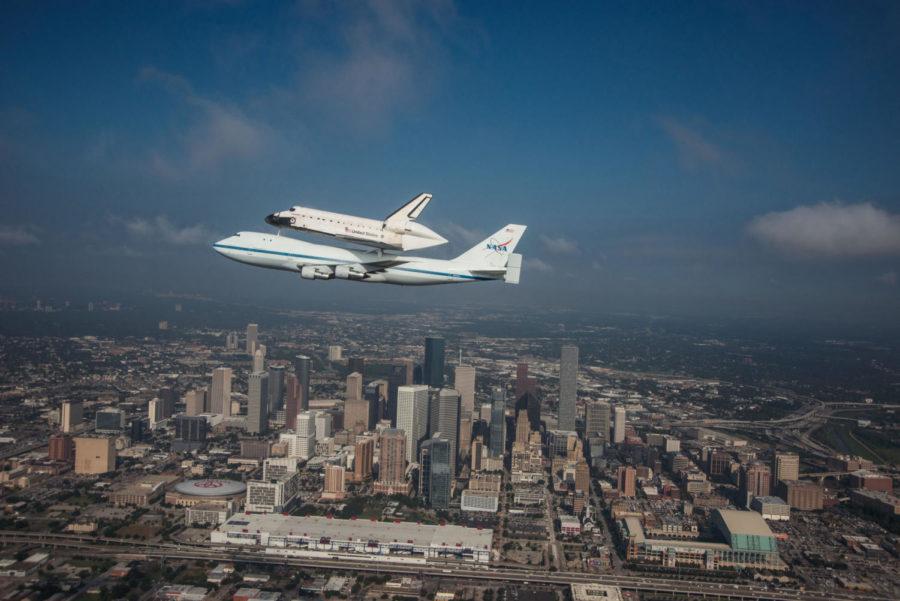Timberlake: NASA officially passes the torch
Photo courtesy NASA/ Sheri Locke
Space Shuttle Endeavour is ferried by NASA’s Shuttle Carrier Aircraft (SCA) over Houston, Texas on September 19, 2012. NASA pilots Jeff Moultrie and Bill Rieke are at the controls of the Shuttle Carrier Aircraft. Photo taken by NASA photographer Sheri Locke in the backseat of a NASA T-38 chase plane with NASA pilot Thomas E. Parent at the controls. Photo Credit: NASA/ Sheri Locke
September 27, 2012
Irony echoed in the California skies over this last weekend. Space Shuttle Endeavor made its final flight while riding aback the modified Boeing 747 Shuttle Carrier Aircraft. In one last great homage, Space Shuttle Endeavor ferried its way across the nation, passing over key locations and making it virtually the most encompassing air show in history.
Flybys included places such as: The Kennedy Space Center, Johnson Space Center, Gabby Giffords’ home, NASA Ames Research Facility, The Queen Mary, Disneyland, Universal Studios, White Sands Missile Range, Jet Propulsion Lab, Dryden Flight Research Center, and eventually landing at LAX to be put on display at the California Science Center. The irony is Endeavor made one of its last flyovers above SpaceX headquarters in Hawthorne, Calif.
SpaceX being the leading (and essentially only) contender for American human space-flight in the near future, NASA shows a bit of a political message by flying over the private corporation, if not a little bit of public relations. Maybe even a bit of passing on national responsibility. A passing of the torch, figuratively.
While it is my belief that the American government should do everything within its power to advance the space program, this rare bit of irony is a calling sign that the government actually needs our help as a people to put our foot on new frontier. Commercial space-flight is on the cusp of becoming a competitive, marketable industry. With SpaceX’s Falcon Heavy, Virgin Galactic’s LauncherOne, Reaction Engine Limited’s SABRE, we are bound for a spillover into the regular market.
This isn’t to say that government space organizations are going to become obsolete. In fact, I think the opposite. What the government will always be able to provide is incentive for dreamers of today to become the achievers of tomorrow. So long as humans are interested in space, the government will have a vested interest to be a part of it. Be it colonizing moons or planets, providing space defense, laying claim to mineral deposits, averting apocalyptic asteroids or most decidedly, research of the cosmos, the government will be ever-present through education, research grants and scholarships, as well as major national political decisions.
Even though NASA seemingly passed the torch of responsibility onto SpaceX, private corporations will vie for a market in space travel, not so much scientific research. These corporations have a market to create and fill and will likely succeed in the near future. The shift is subtle, though. I equate it to the difference between engineers and physicists. Physicists work on the expansion of scientific knowledge within the universe while engineers take that knowledge and apply it.
SpaceX and other up-and-coming corporations will be taking the research that the government programs continue to provide and apply it to the market in a competitive manner. In other words, I believe you should be rooting for the success of the private space industry while monetarily supporting the government sectors responsible for the research, such as NASA.
The glory of NASA might have burnt out as far as the public is concerned, only because they are no longer the ones in the spotlight sending astronauts on heroic missions to the moon. NASA is becoming the voice behind the character in animation films. Or better yet, the fuel for the fire.
Private corporations will help remove the need to innovate on the basis of politics because their funds won’t come from just the national budget nor a red scare. In order for NASA (read, government) to design and build asteroid aversion technology, NASA has to be able to give a reason to the people for spending their money in that light. As sad as it sounds, the public won’t have any of it unless there is an asteroid bumbling silently through space at 90,000 miles per hour with a target destination called “the Atlantic Ocean”.
By that account, we all might as well be dead.
The competition of private space corporations will naturally beget a space race, minus the nuclear warheads. It will reduce the cost of all things space-related, it will create jobs, it will inspire, educate and maybe most importantly, save the human species. NASA has assumed the role of the researcher and educator and maybe, just maybe, that’s where they best function.
After all, Neil Armstrong did say, “I am, and ever will be, a white-socks, pocket-protector, nerdy engineer, born under the second law of thermodynamics, steeped in steam tables, in love with free-body diagrams, transformed by Laplace and propelled by compressible flow.”







